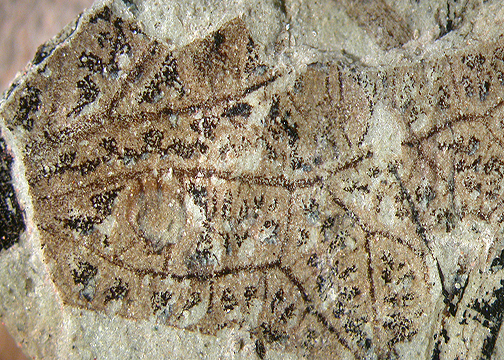Abstract
The family Ipsviciidae, originally described from the Upper Triassic of Australia and considered an offshoot of the Scytinopteridae (Tillyard, 1919), was later variously assigned to Heteroptera, Coleorrhyncha, Fulgoroidea, or Cicadomorpha (Cercopoidea or its own superfamily) by different authors (see Lambkin, 2020). Shcherbakov (1984) placed Ipsviciidae in the Scytinopteroidea and demonstrated that this superfamily is ancestral to Heteroptera (Shcherbakov, 1996). The family comprises several genera known from the Triassic and Lower Jurassic of Australia and Eurasia (Lambkin, 2020). A peculiar monotypic genus of Ipsviciidae with a strigil (stridulatory area) on the underside of the tegmen is described below from the Middle to Upper Triassic (Ladinian–Carnian) of the Madygen Lagerstätte, Central Asia. Such a strigil indicates that the new species possessed a stridulatory device of the forewing-hindleg type, similar to those occurring in the extinct Dysmorphoptilidae (Evans, 1961) and some extant true bugs (see Discussion). Dysmorphoptilids and the new ipsviciid genus may have used these devices to produce alarm signals.
References
- Ashlock, P.D. & Lattin, J.D. (1963) Stridulatory mechanisms in the Lygaeidae, with a new American genus of Orsillinae (Hemiptera: Heteroptera). Annals of the Entomological Society of America, 56, 693–703. https://doi.org/10.1093/aesa/56.5.693
- Becker-Migdisova, E.E. (1962) Some new Hemiptera and Psocoptera. Paleontologicheskii Zhurnal, 89–104. [In Russian]
- Boulard, M. (2006) Acoustic signals, diversity and behaviour of cicadas (Cicadidae, Hemiptera). In: Drosopoulos, S. & Claridge, M.F. (Eds), Insect sounds and communication: Physiology, behaviour, ecology, and evolution. Taylor & Francis, New York, pp. 331–349. https://doi.org/10.1201/9781420039337.ch25
- Burrows, M. (2006) Jumping performance of froghopper insects. Journal of Experimental Biology, 209, 4607–4621. https://doi.org/10.1242/jeb.02539
- Evans, J.W. (1946) A natural classification of leaf-hoppers. Part 1. Transactions of the Entomological Society of London, 96, 47–60. https://doi.org/10.1111/j.1365-2311.1946.tb00442.x
- Evans, J.W. (1961) Some Upper Triassic Hemiptera from Queensland. Memoirs of the Queensland Museum, 14, 13–23.
- Fujiyama, I. (1973) Mesozoic insect fauna of East Asia. Part I. Introduction and Upper Triassic faunas. Bulletin of the National Science Museum, Tokyo, 16, 331–386.
- Gorochov, A.V. (2005) [Review of Triassic Orthoptera with descriptions of new and little known ]axa: Part 2]. Paleontologicheskiï Zhurnal, 3, 46–54. Published in English in Paleontological Journal, 39 (3), 272–279.
- Handlirsch, A. (1906–1908) Die fossilen Insekten und die Phylogenie der rezenten Formen. Verlag von Wilhelm Engelmann, Leipzig, ix + 1430 pp. + 51 pls. https://doi.org/10.5962/bhl.title.34145
- Lambkin, K.J. (2020) Revision of the Ipsviciidae of the Late Triassic of Queensland (Hemiptera: Cicadomorpha: Scytinopteroidea). Zootaxa, 4860 (4), 503–520. https://doi.org/10.11646/zootaxa.4860.4.2
- Leston, D. (1957) The stridulatory mechanisms in terrestrial species of Hemiptera Heteroptera. Proceedings of the Zoological Society of London, 128, 369–386. https://doi.org/10.1111/j.1096-3642.1957.tb00331.x
- Lin, Q.B. (1982a) Class Insecta. In: Nanjing Institute of Geology and Mineral Resources (Ed.), Paleontological atlas of East China. Part 3. Volume of Mesozoic and Cenozoic. Geological Publishing House, Beijing, pp. 148–155. [In Chinese]
- Lin, Q.B. (1982b) Class Insecta. In: Xi’an Institute of Geology and Mineral Resources (Ed.), Paleontological atlas of Northwest China. Shaanxi Gansu Ningxia Volume. Part III. Mesozoic and Cenozoic. Geological Publishing House, Beijing, pp. 70–83. [In Chinese]
- Linnaeus, C. (1758) Systema naturae per regna tria naturae, secundum classes, ordines, genera, species, cum characteribus, differentiis, synonymis, locis. Tomus I. Editio decima, reformata. Laurentii Salvii, Holmiae, [4] + 824 pp. https://doi.org/10.5962/bhl.title.542
- Luo, C.Q. & Wei, C. (2015) Stridulatory sound-production and its function in females of the cicada Subpsaltria yangi. PLoS One, 10, e0118667. https://doi.org/10.1371/journal.pone.0118667
- Papier, F., Nel, A., Grauvogel-Stamm, L. & Gall, J.-C. (1997) La plus ancienne sauterelle Tettigoniidae, Orthoptera (Trias, NE France): mimétisme ou exaptation? Paläontologische Zeitschrift, 71, 71–77. https://doi.org/10.1007/BF03022547
- Polhemus, J.T. (1976) Shore bugs (Hemiptera: Saldidae, etc.). In: Cheng, L. (Ed.). Marine insects. North-Holland, Amsterdam, pp. 225–262.
- Schaefer, C.W. & Pupedis, R.J. (1981) A stridulatory device in certain Alydinae (Hemiptera: Heteroptera: Alydidae). Journal of the Kansas Entomological Society, 54, 143–152.
- Shcherbakov, D.E. (1984) Systematics and phylogeny of Permian Cicadomorpha (Cimicida and Cicadina). Paleontological Journal, 2, 87–97.
- Shcherbakov, D.E. (1996) Origin and evolution of the Auchenorrhyncha as shown by the fossil record. In: Schaefer, C.W. (Ed.), Studies on hemipteran phylogeny. Entomological Society of America, Lanham, Maryland, pp. 31–45.
- Shcherbakov, D.E. (2002) The 270 million year history of Auchenorrhyncha (Homoptera). Denisia, 4, 29–36.
- Shcherbakov, D.E. (2008) Madygen, Triassic Lagerstätte number one, before and after Sharov. Alavesia, 2, 113–124.
- Shcherbakov, D.E. (2011) New and little-known families of Hemiptera Cicadomorpha from the Triassic of Central Asia—early analogs of treehoppers and planthoppers. Zootaxa, 2836 (1), 1–26. https://doi.org/10.11646/zootaxa.2836.1.1
- Shcherbakov, D.E. (2021) New Curvicubitidae and Paraknightiidae (Homoptera: Cicadomorpha) from the Triassic of Central Asia. Russian Entomological Journal, 30, 129–134. https://doi.org/10.15298/rusentj.30.2.02
- Shcherbakov, D.E. (2022) New Dysmorphoptilidae (Cicadomorpha) from the end-Permian and Middle Jurassic of Siberia: earliest evidence of acoustic communication in Hemiptera and the latest find of the family. Russian Entomological Journal, 31, 108–113. https://doi.org/10.15298/rusentj.31.2.02
- Siwanowicz, I. & Burrows, M. (2017) Three dimensional reconstruction of energy stores for jumping in planthoppers and froghoppers from confocal laser scanning microscopy. eLife, 6, e23824. https://doi.org/10.7554/eLife.23824
- Tillyard, R.J. (1919) Mesozoic insects of Queensland. No. 7. Hemiptera Homoptera; with a note on the phylogeny of the suborder. Proceedings of the Linnean Society of New South Wales, 44, 857–896.
- Tillyard, R.J. (1922) Mesozoic insects of Queensland. No. 9. Orthoptera, and additions to the Protorthoptera, Odonata, Hemiptera and Planipennia. Proceedings of the Linnean Society of New South Wales, 47, 447–470.
- Voigt, S., Buchwitz, M., Fischer, J., Kogan, I., Moisan, P., Schneider, J.W., Spindler, F., Brosig, A., Preusse, M., Scholze, F. & Linnemann, U. (2017) Triassic life in an inland lake basin of the warm-temperate biome—the Madygen Lagerstätte (southwest Kyrgyzstan, Central Asia). In: Fraser, N.C. & Sues, H.-D. (Eds), Terrestrial conservation Lagerstätten—windows into the evolution of life on land. Dunedin Academic Press, Edinburgh, pp. 65–104.
- Wessel, A., Mühlethaler, R., Hartung, V., Kuštor, V. & Gogala, M. (2014) The tymbal: evolution of a complex vibration-producing organ in the Tymbalia (Hemiptera excl. Sternorrhyncha). In: Cocroft, R.B., Gogala, M., Hill, P.S.M. & Wessel, A. (Eds), Studying vibrational communication. Springer, Berlin, Heidelberg, pp. 395–444. https://doi.org/10.1007/978-3-662-43607-3_20


